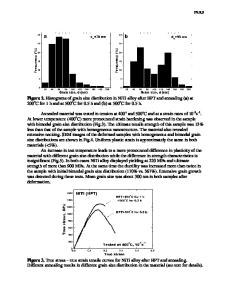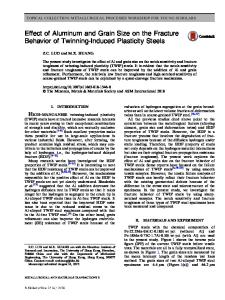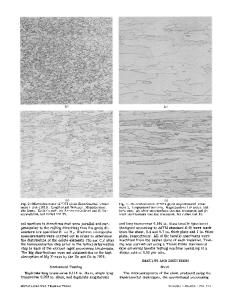The effect of grain size on the high-strain, high-strain-rate behavior of copper
- PDF / 3,916,240 Bytes
- 13 Pages / 598 x 778 pts Page_size
- 63 Downloads / 425 Views
I.
INTRODUCTION
W H E R E A S the effect of grain size on the quasistatic response of copper has been extensively studied,tl-S] its high-strain-rate response has only recently received attention. Quasistatic experiments yield flow stress-grain size relationships that can be conveniently fit into a Hall-Petch type equation, although there is substantial variation in the Hall-Petch parameters. This relationship seems to break down in the nanocrystalline region,t7] where other deformation mechanisms may become operative. Schmidt et al.[81 investigated the effect of grain size on the high-strain-rate deformation of copper but had a range of grain sizes that was quite narrow: 16 to 54/zm. They obtained, as the most significant effect, an increased surface roughness (after plastic deformation) for the 54-/xm specimens. Gourdin and LassilatS,6] tested copper specimens with grain sizes of 10, 50, 100, and 175 /xm in the strain-rate range of 1 • 10 -3 to 1 • 10z s -1 and applied the mechanical threshold stress constitutive equation to the results. The flow stress at low and high strain rates clearly followed a Hall-Petch relationship, and the Hall-Petch slope was not very sensitive to strain rate. Recently, Nesterenko and co-workers tg,l~ investigated the instability of plastic flow in dynamically loaded hollow copper cylinders (subjected to external loading by explosives) with grain sizes of 30, 100, and 1000
MARC A. MEYERS, Professor of Materials Science, is with the Department of Applied Mechanics and Engineering Sciences, University of California, San Diego, La Jolla, CA 92093-0411. UMBERTO R. ANDRADE, formerly with the Department of Applied Mechanics and Engineering Sciences, University of California, is Professor, Department of Materials Science, Military Institute of Engineering, 22290 Rio de Janeiro, Brazil. ATUL H. CHOKSHI, formerly with the Department of Applied Mechanics and Engineering Sciences, is Professor, Department of Metalhtrgy, Indian Institute of Science, 560012 Bangalore, India. Manuscript submitted October 4, 1993. METALLURGICALAND MATERIALSTRANSACTIONSA
5 ~
Data Loading...











